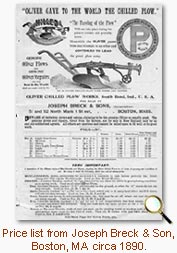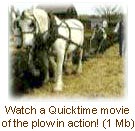| "The Passing of the Plow will not take place during the present century and probably never."
 So stated a price list for Oliver Chilled Plows printed in about 1890. The confidence and qualification of this assertion showed prescience. No matter what happened, agricultural implement producers and sellers believed the plow would always play a role in farming. So stated a price list for Oliver Chilled Plows printed in about 1890. The confidence and qualification of this assertion showed prescience. No matter what happened, agricultural implement producers and sellers believed the plow would always play a role in farming.
American farmers and inventors had long sought the perfect metal plow. Since the 1810s, farmers turned the earth with cast iron plows comprised of interchangeable parts. The iron in these implements contained a number of imperfections. Inferior metal that wore down or brittle cast iron that broke when it hit an obstruction caused farmers to purchase new components since cast iron could not be welded by blacksmiths.
Throughout the middle of the nineteenth century, plowmakers and blacksmiths experimented with other metals including wrought iron and steel. John Lane of Lockport, Illinois is credited with developing the first steel plow in 1831. However, the cost of steel proved prohibitive until 1856 when the Bessemer process improved steel production. Steel plows still remained more costly than cast iron plows, but both were popular.
By 1870, American farmers had a number of excellent options including the latest development - "chilled" cast iron. As early as 1810 inventors experimented with "chilling," cooling the cast iron quickly with a stream of water to harden the metal. This made the iron harder than traditional cast iron, and allowed it to turn the earth more efficiently. James A. Oliver, a Scotsman removed to South Bend, Indiana perfected this process, and began to sell chilled plows in 1870. By the 1890s, his was the largest plow works in the United States. Many farmers across the United States used Oliver Chilled Iron plows.
 The popularity of the Oliver Chilled Plow for American farmers is demonstrated in the The Henry Ford collections. The plow shown here is an Oliver #20 walking plow. It cost about $9.00 in 1890. We use another Oliver Chilled Plow at Firestone Farm during the Greenfield Village Spring Farm Days event. The effectiveness and budget price of Oliver Chilled Plows encouraged knock-offs and frauds. The company's advertisements warned buyers "to beware of worthless imitations" and to look for the name "Oliver" on the beam to get the genuine article. Our #20 has "Oliver" stenciled nicely across the top of the beam. The popularity of the Oliver Chilled Plow for American farmers is demonstrated in the The Henry Ford collections. The plow shown here is an Oliver #20 walking plow. It cost about $9.00 in 1890. We use another Oliver Chilled Plow at Firestone Farm during the Greenfield Village Spring Farm Days event. The effectiveness and budget price of Oliver Chilled Plows encouraged knock-offs and frauds. The company's advertisements warned buyers "to beware of worthless imitations" and to look for the name "Oliver" on the beam to get the genuine article. Our #20 has "Oliver" stenciled nicely across the top of the beam.
Oliver Chilled Plow Works produced about 250,000 plows in their first fifteen years, and the plow remained popular into the twentieth century. But by the 1930s, soil conservationists recognized that conventional plowing caused erosion from wind and water. Though tractor-drawn plows are used today, the implements are falling out of favor. In 1998, for the first time conservation tillage surpassed conventional tillage as a method of seedbed preparation. Conservation tillage is a technique that stirs the soil, but leaves a ground cover that prevents erosion. Contrary to the earlier assertion, the days of the plow may be numbered.
For more information:
Read a Newsletter about Conservation tillage at www.purdue.edu/UNS/html4ever/9802.Evans.notill.html
Learn more about conservation tillage and other farming practices at the University of California-Davis Sustainable Agriculture Web site at www.sarep.ucdavis.edu/concept.htm |

